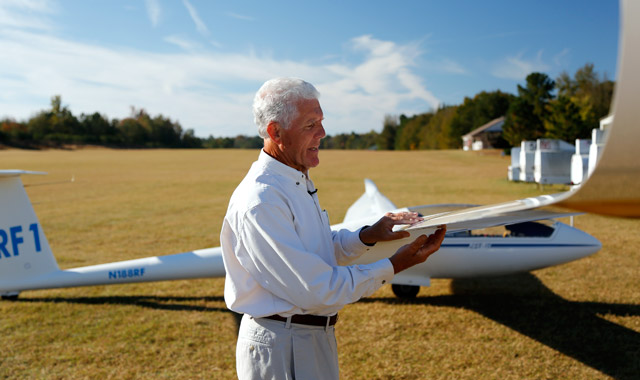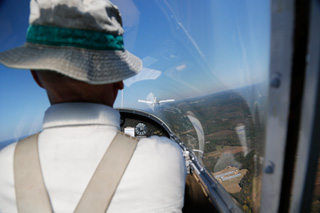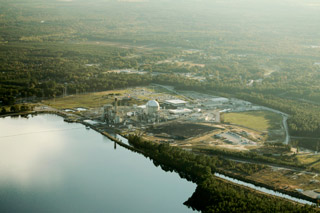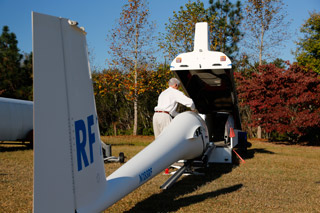Pilots returned, one by one, to Bermuda High Soaring in Jefferson, S.C. By about 5 p.m. on July 26, 2012, the lift had died and everyone had returned to the gliderport—everyone except Robin Fleming. No one remembered hearing from Fleming since 1:30 or 2 p.m., and Jayne Ewing Reid, co-owner and chief tow pilot of the glider club and commercial operation, was worried.
She called pilots who lived in the region and asked them to try to contact Fleming on their handheld radios. She flew the club’s Piper Pawnee in the direction of Fleming’s last known radio call, but found no evidence of the missing glider or its pilot.
“This is when you get that feeling that something’s not right,” she said. Fleming always called if he landed out. Worried that something had happened to Fleming, an avid glider pilot and instructor at Bermuda High, Jayne Ewing Reid and business partner Frank Reid decided to file a missing airplane report. Neither suspected that Fleming was in trouble with the law.
Fleming, 70, had been arrested for breach of peace after flying his Rolladen-Schneider LS8-18 sailplane noiselessly over the H.B. Robinson Nuclear Generating Station at an altitude of 1,518 feet msl—by his estimates, about 1,000 feet over the power plant’s dome—on his way to search for lift at nearby Lake Robinson.
No airspace restrictions were printed on sectional charts; no notam marked the area off-limits. When a woman at Hartsville Regional Airport relayed over the Unicom that law enforcement wanted him to land, he had flown to that airport and landed, greeted by a swarm of law enforcement vehicles.
Nonetheless, Fleming spent the night awake in a cell with 11 other inmates. The next afternoon, still in custody, he discovered the details of the charges: “flying very close to the nuclear plant dome in a ‘no fly zone,’” “escalated a multi-jurisdictional call out to a homeland security situation,” “ordered several times to land,” “causing the disturbance throughout the community.”
He finally left the detention center 24 hours after his arrest, exhausted and eager to clear his name. The charges were dropped the next month, but now Fleming wants to make sure no other pilots are subjected to a similar ordeal.
 Robin Fleming regularly flies his glider out of Bermuda High Soaring and instructs there on the weekends. He never expected that flying the whisper-quiet craft would land him with a breach of peace charge.
Robin Fleming regularly flies his glider out of Bermuda High Soaring and instructs there on the weekends. He never expected that flying the whisper-quiet craft would land him with a breach of peace charge.
The arrest
Fleming took off from Bermuda High Soaring in Jefferson, S.C., at 12:41 p.m. that day, towed to 2,000 feet agl by one of the private airfield’s Piper Pawnees. He had intended to fly to Asheboro, N.C.; Dillon, S.C..; and Winnsboro, S.C., to complete a 500-kilometer course, but in soaring one goes where the lift is. A flight recorder installed in the aircraft for record attempts and competitions shows Fleming’s circling course as he searched for thermals to the east. He had looped down to Bennettsville, S.C., he said, when he decided to head home. The path back to Jefferson, traveling from one small airport to the next in case the lift died down, would take him near Hartsville Regional Airport—and the H.B. Robinson Nuclear Generating Station, two nautical miles away.
He approached Hartsville from the north at 3,100 feet msl, flying southwest toward Lake Robinson to look for lift. He had been up to 5,000 feet earlier in the flight, and knew that it went up that high if he could find it. He just had to get high enough to glide back to Bermuda High.
 The flight started out normally, with an aerotow like this. Jay Campbell, pictured, was among the pilots who searched for Fleming.
The flight started out normally, with an aerotow like this. Jay Campbell, pictured, was among the pilots who searched for Fleming.
On the Charlotte sectional chart, the nuclear power plant is marked with nothing more than a group obstruction symbol. Fleming was familiar with the post-9/11 notam that advises pilots to avoid flying near facilities such as power plants “to the extent practicable,” but he thought nothing of a single pass over the Robinson facility on the west side of the lake as he headed toward where he thought there would be lift at the lake. If he couldn’t find a thermal there, he thought, he might have to land at Hartsville.
At Hartsville Regional Airport, Wendy Griffin was monitoring the Unicom. Griffin said the people at the power plant sometimes call her if they see an aircraft flying nearby to ask her who’s flying and why the aircraft is there. (One time, she said, she got a call about a helicopter lingering in the area and found out from the pilots that they were working for the power plant.) Sometimes she calls the pilots on the frequency to find out their intentions, but on July 26 she saw that it was a glider and didn’t think much of it, she said.
“I said, ‘Well, I really don’t think it’s a threat,’” she said. “’I wouldn’t worry about it.’”
Someone did worry about it. A little before 5 p.m., Griffin said, a couple of police cars rolled up. When the officers came in, she added, she said she’d try to reach the aircraft on the radio.
Looking for lift over Lake Robinson, Fleming was switching between the Bermuda High frequency and Hartsville Unicom to monitor local traffic. He later recalled that during one switch to Hartsville, he heard the end of a transmission mentioning a glider over the nuclear plant. He responded that he was circling and moving away from the plant, he said. He found a thermal, he said, and began climbing to return to Bermuda High.
Fleming recalls that at some point someone requested he land at Hartsville, but then he was told he could continue. He climbed to 3,100 feet msl, circling to the northeast away from the lake, and planned to head back to Bermuda High Soaring; but he lost lift and descended to 1,900 feet msl. He turned toward Hartsville again, but found a thermal and climbed to 2,740 feet. “All I needed was another few hundred feet” to return to Bermuda High, he said. But he received a radio transmission for Hartsville telling him to land.
At the airport, Griffin said the officers on the scene told her to demand the glider land at Hartsville, but that an FAA official on the phone said the FAA was not demanding he land. So, she said, she gave Fleming a choice: “Police officers here are asking you to land, but the FAA says you do not have to land. I’m leaving this up to you.” Fleming said to tell the officers he’d be there in a minute, she recalled.
These accounts seem consistent with the Darlington County Sheriff Department’s incident report. Capt. Joyce C. Everett wrote that the suspect was “advised” to land at Hartsville, and that he had advised he was going to land elsewhere because he didn’t want to have his airplane towed. When he was instructed again to land in Hartsville, Everett wrote, he did. In a supplementary report, Sgt. Christopher J. Pittman wrote, “It is unclear as to exactly how that radio conversation went, but the pilot initially stated that he intended to land at Bermuda High landing strip in Jefferson, SC. After it was made clear that law enforcement expected him to land in Hartsville the pilot stated that he would comply.”
The arrest report, however, paints a different picture, alleging that Fleming “had to be ordered several times to land” before he complied. Griffin strongly contests this version of events: “I was the only one on the unicom with him,” she said. “I never demanded him to land.”
As Fleming landed, Griffin said, about four police cars chased the nonpowered craft down the runway, lights flashing. The glider came to a full stop at 5:11 p.m.
 The H.B. Robinson Nuclear Generating Station lies adjacent to Lake Robinson and a short distance from the Hartsville Regional Airport.
The H.B. Robinson Nuclear Generating Station lies adjacent to Lake Robinson and a short distance from the Hartsville Regional Airport.
Officers approached the aircraft and requested Fleming’s identification and pilot certificate, searched his pockets, subjected him to a pat-down, and took his wallet, cellphone, glasses, and sunglasses, according to Fleming’s account. He asked to call the people waiting for him at Bermuda High to tell them where he was, he said, but was denied. He was told he should consider himself under arrest, he recalled.
“’Haven’t you heard about 9/11?’—that’s what they said to me.”
‘No I’m not kidding’
Later that evening, Jayne Ewing Reid emailed the pilots she had asked for help in the search for Fleming, with news from the FAA: “9:02 pm – Robins plane is reported to be at Hartsville Airport.” There was still no word of its pilot.
Frank Reid called Hartsville Regional Airport and got the surprising news. Jayne Ewing Reid said she was relieved to know Fleming wasn’t in a field somewhere, but still in disbelief.
“Robin is OK !!” she wrote at 9:17 p.m. in an email to the pilots she had updated earlier. “He is in jail. No I’m not kidding.”
Jayne Ewing Reid spoke with Fleming a little later when he was able to make a collect call from his cell, and Frank Reid looked for a lawyer. Fleming’s friends were baffled that the mild-mannered pilot could arrive at such a fate.
“That boy has never had a ticket,” Frank Reid said. “… He is the most laid back and gentle person I have ever seen in my life.”
Breach of peace
The arrest warrant referred to a “no fly zone.” The incident report said that “a glider or drone had infiltrated the restricted airspace over the H.B. Robinson Nuclear Power Plant.” But Fleming knew nothing on the FAA sectional charts prohibited him from flying there.
From flying competitions in the area, he knew that the Savannah River Site, a 310-square-mile Department of Energy industrial complex that handles nuclear materials in support of national defense, is marked on sectionals with a notice requesting—not requiring—that pilots avoid flight at and below 2,000 feet msl in the area. If a nuclear site as large as Savannah River didn’t prohibit overflight, how could the area around the Robinson plant be restricted—especially if nothing said so on the charts?
Facilities such as the Robinson plant are addressed in an FDC notam issued following 9/11: “In the interest of national security and to the extent practicable, pilots are strongly advised to avoid the airspace above, or in proximity to such sites as power plants … . Pilots should not circle as to loiter in the vicinity over these types of facilities.” Because gliders routinely circle to gain altitude in thermals, the Soaring Society of America sought a clarification from the FAA, posting on its website on March 7, 2002, that the FAA did not consider this behavior loitering. “The key is to spend only as much time as needed to gain lift and move on beyond the facility,” the association wrote.
Fleming had made a single pass over the plant, and his circling had been mostly on the opposite side of the lake. The FAA looked into the overflight and later confirmed to AOPA that it found no violation of the federal aviation regulations—but Fleming was transported to the Darlington County Detention Center. The Federal Bureau of Investigation and Department of Homeland Security would interview him the next day, and Fleming said an officer read the arrest warrant to him around 3:30 p.m. July 27.
It’s unclear exactly how the concept of a no-fly zone was introduced, and a spokesman for the Darlington County Sheriff’s Office did not return phone messages requesting comment. Charles Ellison, site communications specialist at the nuclear plant, said that as he understands it, there is no no-fly zone around the facility. He said security staff had estimated that the glider flew about 400 feet above the plant, and so they contacted local law enforcement. “Any time an aircraft is flying that close, we consider it a perceived threat to security.”
Fleming said he understands the nuclear site’s initial concern, but thinks the ordeal could have stopped right there when security personnel who came to question him at the airport saw him in the police car and it became evident he wasn’t a threat. Ellison said it’s the plant’s policy to turn the matter over to local law enforcement. “Once we’ve neutralized the threat, we step back and we remove ourselves from the issue,” Ellison said.
How close was Fleming to the plant? His flight recorder, which logged his position every four seconds, gave the glider’s altitude when it passed over the site as 1,518 feet msl; the highest charted obstruction there is 577 feet msl. The incident report cited security staff as estimating it “within only a few hundred yards of critical structures.” Griffin said she heard security people saying Fleming had flown 100 feet over the dome.
“That just wasn’t true,” she said. “There’s just no way he ever did that.”
Freedom to fly
Fleming estimated he had been awake for almost 30 hours when he entered a room where a special agent from the FBI, an aviation security inspector from DHS, and a woman whose affiliation he can’t remember waited to question him July 27. He recalled that someone told him there was no intention to charge him with any federal offenses related to the incident, and that he was asked to explain the intent of his flight. He explained how he navigated by VFR charts, and that no restrictions were charted or published by notam in the area of the plant.
About 5:30 p.m., Fleming collected his pilot certificate and other belongings. Pilots from Bermuda High met him at the detention center and drove him to Hartsville to retrieve his glider.
 Fleming was unable to stow his aircraft safely in its trailer while he was in custody for 24 hours.
Fleming was unable to stow his aircraft safely in its trailer while he was in custody for 24 hours.
The attorney Frank Reid had found represented Fleming for the breach of peace charge, but Fleming sought additional assistance from an attorney familiar with aviation through AOPA’s Legal Services Plan/Pilot Protection Services. John Hodge, an attorney and 17,000-hour pilot who has flown gliders, provided aviation-related information under the plan’s 20 hours allotted for local law enforcement issues. From the FAA’s perspective, Fleming’s flight was legal and legitimate: No restricted or prohibited areas were charted. Plus, local law enforcement does not have the authority to order an aircraft to land, Hodge said. And any argument that Fleming delayed in complying with the request to land must take into account the nature of a sailplane: Just like a sailboat, it can’t simply go directly from Point A to Point B.
A better knowledge of aviation issues among law enforcement officials may have produced a better result for Fleming. Griffin said she had to tell the officers on the scene to clear out the runway, and one officer talked about commandeering the airport. “He was running around, the one guy that was commandeering everything, saying, ‘We were going to shoot him down,’” she said.
On the other hand, Griffin said that pilots from the Chesterfield County Sheriff flew the department’s helicopter to the airport, but left when they found out what was going on. “They pulled out a chart and they said, ‘Look here, … nothing in this chart says you cannot fly over the nuclear plant,’” she said. “’Nothing.’”
Protecting pilots
Fleming waited outside the courtroom Aug. 21 as his case went before the judge. When his attorney returned and said the case would be dismissed if he agreed not to take any legal action against Darlington County law enforcement, he said, he reluctantly agreed. But he wouldn’t be satisfied until he could be sure a pilot can rely on the sectional for direction and not go through a similar ordeal.
In a post-9/11 environment, pilots must be sensitive to security concerns, but that doesn’t mean they must give up their freedom to fly. In its communication to members about the rules for flying near power plants and other infrastructure, the Soaring Society of America called on glider pilots to reach out to on-site security at local power plants and laboratories: “Open a dialogue and tell them who you are and when you may be in their area.” In addition, airports often encourage pilots to “fly friendly” in sensitive areas; the Hartsville airport has a right traffic pattern for Runway 3, keeping pilots on the far side of the airport as much as possible and minimizing overflight of the nuclear plant. But no law prohibits pilots from flying over it, and AOPA is working to ensure that law enforcement agencies and security at critical infrastructure understand how to respond appropriately when they have a concern about an aircraft.
AOPA routinely works with federal agencies on security issues, and the association reached out to staff at the TSA and National Protection and Programs Directorate to inform them of the issue. The association requested action formally in a letter to DHS, the organizations’ parent agency.
“This incident raises several disturbing issues that demand the immediate attention of the Department of Homeland Security to prevent unnecessarily detaining United States Citizens, or even worse, needlessly causing injuries or fatalities that would have resulted from a ‘shoot down’ of the aircraft,” wrote AOPA Senior Vice President Melissa Rudinger in the letter. She urged the department to “immediately conduct a thorough review of all security programs for similar types of facilities to ensure that it is clear on what constitutes a violation and what is the appropriate action to be taken.” She also requested that DHS make it clear that no one may shoot down an aircraft outside of the existing command structure.
The TSA responded in a letter that it takes these matters seriously—“Both in context of aircraft loitering in airspace around critical infrastructure as well as appropriateness of responses by various organizations at the Federal, State, and Local levels.” The agency said it would continue to work with organizations at all levels “by providing them with education on airspace matters via the local TSA Federal Security Directors and headquarters engagement. This will allow them to make informed and effective decisions on when and how best to execute a response based on their specific statutory and/or legal authorities.” AOPA continues to press the agency, along with the National Protection and Programs Directorate which deals with infrastructure protection, to explain what these education efforts entail; the association also has offered to assist in developing guidance and resources on general aviation-related issues.
AOPA General Counsel Ken Mead emphasized the importance of continued advocacy, explaining that it is “outrageous under these circumstances to be confined in jail without charges being filed for this length of time." He added, "We should be persistent in demanding corrective action as well as better educational efforts of law enforcement authorities. Although the breach of peace arrest warrant that was ultimately filed refers to a ‘No Fly Zone’ neither the federal nor local authorities could cite a federal violation because this was not a ‘No Fly Zone.’”
Look for further coverage in February AOPA Pilot’s “Breach of peace.” For more information on AOPA’s Legal Services Plan/Pilot Protection Services, visit the website.


